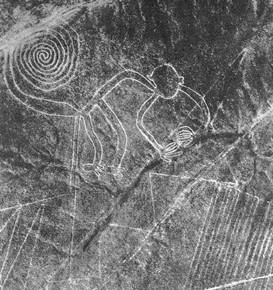Mid-morning we stopped at Chauchilla Necropolis/Cemetery in the Valley of Nazca. This area is one of the driest on earth with less than 25mm rain per year with it being 50 kilometers from the sea and completely surrounded high mountains. It was here in 1926 that about 400 graves were found with probably all containing mummified bodies but only a few have been excavated as yet. It was because of the dry atmosphere that the bodies, clothing and ceramics have been preserved. The burials, not sacrifices, were carried out by the Nazca people between 300 BC and 700 AD, well before the Inca were around. Although the area is dry now for there to have been a civilization there and the finding of large quantities of cotton on the bodies there must have been plenty of water in the valley.
We were escorted round the burial place by an official guide and he said that we could take photos without placing any restrictions on us. I did prefer seeing the mummies in their natural pace rather than behind glass in a museum; to see the way the skulls (heads) had been elongated by children having had their heads bound from birth as a fashion statement; and to see the clothing the bodies were buried with together with the items buried with them.
Views of the Necropolis

From the cemetery we were taken to the Centre Ceremonial De Cahuachi. Again,
there must have been water in the area in the past for such an extensive area
to have been built on. It
was a major ceremonial center of the Nazca culture from about 1 AD to about 500 AD in the coastal area of the Central Andes and overlooked some of the Nazca Lines. T
he permanent population was quite small and it is believed that this was a pilgrimage center, whose population increased greatly in relation to major ceremonial events.
Because of the heat , 37C in the shade, the visit was called off due to complaints from the group. From here we went to the Hotel Fundo San Rafael in Nascar where some of us had paid extra to have a room whilst others camped on the hotel grass. Later I went on a flight over the Nazca Lines which was done in a single engined plane with seats for four passengers. There were only three passengers and two pilots, one of which talked us through what we were seeing (we were given headphones, not that I could see half of the figures) and he took my camera to take photos for me. When I looked at the photos I still could not make out the figures and I think he actually missed the figures anyway.
The Nazca Lines are a series of large ancient geoglyphs with f
igures up to 370 metres (1,200 ft) long. The plateau stretches more than 80 km (50 miles). Although some local geoglyphs resemble Paracas motifs, scholars believe the Nazca Lines were created by the Nazca culture between 500 BC and 500 AD. Hundreds of the lines are simple lines and geometric shapes; more than 70 are zoomorphic designs of animals, such as birds, fish, llamas, jaguars, and monkeys, or human figures. Other designs include phytomorphic shapes, such as trees and flowers. The designs are shallow lines made in the ground by removing the reddish pebbles and uncovering the whitish/grayish ground beneath and are believed to have some religious meaning.
The four photos below were taken by the pilot or myself. Make of them what you will.
These others are from the internet.
 |
| The humming bird |
 |
The monkey
|

















No comments:
Post a Comment